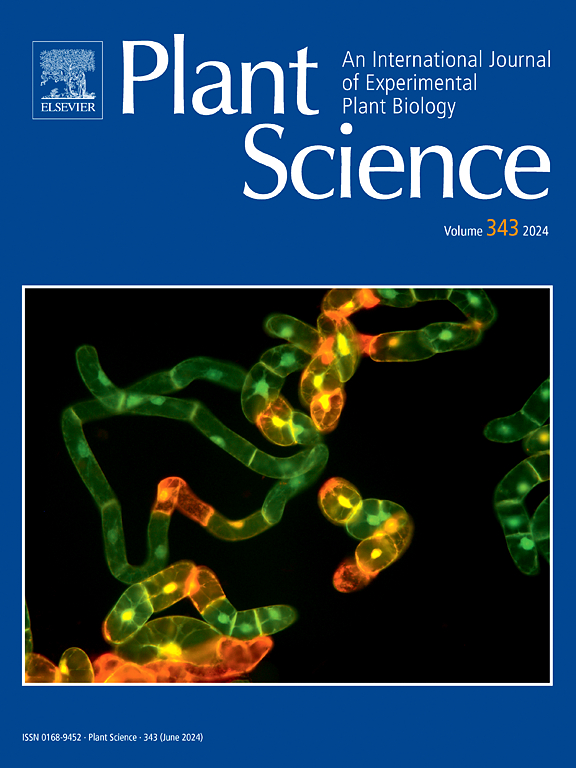黄瓜(Cucumis sativus L.)早期衰老相关CsPHYB基因LTR反转录转座子插入位点的鉴定与功能分析
IF 4.2
2区 生物学
Q2 BIOCHEMISTRY & MOLECULAR BIOLOGY
引用次数: 0
摘要
植物早期衰老对光合效率、作物产量和植株整体活力有显著影响。在这项研究中,我们鉴定了一个自发的黄瓜突变体NW079,表现出叶片过早泛黄,叶绿素含量降低,光合性能受损。为了揭示这种表型的遗传基础,我们生成了F₂定位群体,并采用了批量分离分析和精细定位。这些努力导致在编码光敏色素b的CsPHYB基因的第一个外显子内鉴定了5.5 kb长的终端重复(LTR)反转录转座子插入,该插入破坏了正常剪接并产生了两个异常的转录变体:一个包含261 bp的LTR衍生序列,其中包含过早停止密码子,另一个由于外显子跳变而包含1,914 bp的缺失。预计这两种变异都会产生截断的、无功能的蛋白质。功能分析表明,CsPHYB缺乏导致对不同光质量和强度的敏感性提高,导致叶片显着变黄和叶面积减少。RNA测序显示,NW079中存在广泛的转录重编程,其中580个差异表达基因(DEGs)与血红素代谢、四吡咯结合和叶绿体发育有关。这些转录中断与观察到的叶绿体结构和功能异常密切相关。该研究为了解黄瓜早期衰老提供了一个分子框架,为提高作物抗逆性和生产力的育种策略提供了有价值的见解。在黄瓜CsPhyB的第一个外显子上插入LTR反转录转座子,破坏了其表达和剪接,导致叶片过早衰老。这一发现为CsPHYB在叶绿体发育和光信号传导中的作用提供了新的见解,为黄瓜育种计划提供了有价值的分子标记和靶基因,重点是提高产量和抗逆性。本文章由计算机程序翻译,如有差异,请以英文原文为准。
Identification and functional analysis of an LTR retrotransposon insertion in CsPHYB associated with early senescence in cucumber (Cucumis sativus L.)
Early senescence in plants significantly affects photosynthetic efficiency, crop yield, and overall plant vigor. In this study, we identified a spontaneous cucumber mutant, NW079, exhibiting premature leaf yellowing, reduced chlorophyll content, and impaired photosynthetic performance. To uncover the genetic basis of this phenotype, we generated F₂ mapping populations and employed bulked segregant analysis and fine mapping. These efforts led to the identification of a 5.5-kb long terminal repeat (LTR) retrotransposon insertion within the first exon of CsPHYB, a gene encoding phytochrome B. This insertion disrupted normal splicing and gave rise to two aberrant transcript variants: one containing a 261-bp LTR-derived sequence with premature stop codons, and the other harboring a 1,914-bp deletion due to exon skipping. Both variants are predicted to produce truncated, nonfunctional proteins. Functional analyses revealed that CsPHYB deficiency resulted in heightened sensitivity to varying light qualities and intensities, leading to pronounced leaf yellowing and reduced leaf area. RNA sequencing revealed widespread transcriptional reprogramming in NW079, with 580 differentially expressed genes (DEGs) implicated in heme metabolism, tetrapyrrole binding, and chloroplast development. These transcriptional disruptions were closely linked to the observed structural and functional abnormalities in chloroplasts. This study provides a molecular framework for understanding the early senescence in cucumber, offering valuable insights for breeding strategies aimed at improving crop resilience and productivity.
Keymessage
An LTR retrotransposon insertion in the first exon of CsPhyB disrupts its expression and splicing, leading to early leaf senescence in cucumber. This finding provides novel insights into the role of CsPHYB in chloroplast development and light signaling, offering valuable molecular markers and a target gene for cucumber breeding programs focused on enhancing yield and stress resilience.
求助全文
通过发布文献求助,成功后即可免费获取论文全文。
去求助
来源期刊

Plant Science
生物-生化与分子生物学
CiteScore
9.10
自引率
1.90%
发文量
322
审稿时长
33 days
期刊介绍:
Plant Science will publish in the minimum of time, research manuscripts as well as commissioned reviews and commentaries recommended by its referees in all areas of experimental plant biology with emphasis in the broad areas of genomics, proteomics, biochemistry (including enzymology), physiology, cell biology, development, genetics, functional plant breeding, systems biology and the interaction of plants with the environment.
Manuscripts for full consideration should be written concisely and essentially as a final report. The main criterion for publication is that the manuscript must contain original and significant insights that lead to a better understanding of fundamental plant biology. Papers centering on plant cell culture should be of interest to a wide audience and methods employed result in a substantial improvement over existing established techniques and approaches. Methods papers are welcome only when the technique(s) described is novel or provides a major advancement of established protocols.
 求助内容:
求助内容: 应助结果提醒方式:
应助结果提醒方式:


